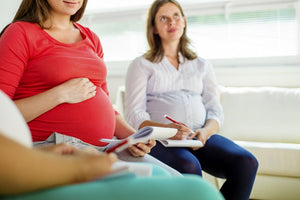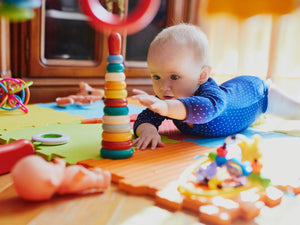Pregnancy brings with it a lot of joy for the parents-to-be. But there are often worries and stress about how many things need to be ticked off a list before you can go on maternity or parental leave especially if both partners are working in full time jobs.
You need to consider parental leave entitlements, when to apply for parental leave pay, when to tell your employer about the baby and preparing financially for a baby. Our advice is not to leave it all to the last minute. 9 months can seem like a long time but it’ll go fast!
We’ve put together a handy checklist for parents-to-be on preparing your career and employer for a baby to ensure a smooth transition when you’re ready to take leave.
8 weeks: Notify your employer
You can notify your boss formally as early as 8 weeks into the pregnancy. It’s best to share the news with your boss first so that you and they can think and plan ahead to how workload and responsibilities will be managed in your absence.
The Fair Work Ombudsman sets out guidelines on its website on how and when employees can apply for parental leave and what’s expected of you legally. The Australian government has its own website for working parents.
8-10 weeks: Know your entitlements as a pregnant employee
As a pregnant employee, you are entitled to sick leave and/or special maternity leave and have a right to ask for a safe job (a medical certificate needs to be provided) if your current position is deemed dangerous to your pregnancy. You should still get the same pay, hours and rate that you received in your previous role. The law also forbids employers from discriminating against pregnant employees by reducing their hours or cutting pay.
13 weeks
You can formally announce your pregnancy to your team members and the rest of the office if they haven’t guessed already!
18- 20 weeks: Start delegating to team members
Identify which parts of your role can be delegated. Get your team members’ input via one-on-one discussions on how they’d feel about stepping up and assuming more responsibility in your absence and what they need to help them do it well, for example, extra training.
25 weeks: Take antenatal classes
While you’re preparing yourself at work, don’t forget to take antenatal classes to prepare yourself for the baby’s birth. Antenatal classes are incredibly useful for first time parents because they tell you what to expect during the birth process, post delivery care and how to care for your little human. If you don’t have the time for classes at your local hospital or birth centre, online antenatal classes where you learn in your own time might be a better option.
30 weeks: Parental leave and related entitlements
The most time consuming process in applying for parental leave is filling out the numerous parental leave forms for Centrelink. Kristine Evans, Founder and Speaker Mummy Jobs Australia, recommends filling out the forms when you’re at thirty weeks. You can choose to have the payments paid directly into your account or through your employer.
Decide on:
- amount of leave between you and partner
- who’ll be the primary caregiver
- if you’ll need childcare once the baby is born or ask grandparents for help
- whether you want to share payments and leave with your partner
- your start and finish dates for parental leave
Remember, there’s a time limit on when you can claim the full parental leave pay. To receive payment for the full 18 weeks the forms need to be lodged within 7 months of your child’s birth (34 weeks).
34 weeks: Prepare for handover
At around 33-34 weeks you should be handing over most of your responsibilities to the designated employee or at least reducing the scope of your role. Team members should be brought up to speed with managing projects in your absence and trained to take on extra responsibilities.
You need to factor in some leniency of a finish date as the last 5-10 weeks of pregnancy can be exhausting. For dads who take time off for their partner’s delivery, get all the important work tasks/projects ticked off in case bub makes an early entrance and you need to bolt! You need to be present 100 percent with mum and bub once the big day arrives,” said Kristine.
34 weeks: Make an appointment with HR
If you’ve decided to take maternity leave from 36 weeks onwards as many women do, then make an appointment with HR to discuss your exit, employee handover, method of communication preferred when informing the company of major changes that might affect your return and how often you’d like to stay in touch. It’s a good time to voice any concerns and discuss flexible arrangements for your return to work including hours of work, breastfeeding or pumping breastmilk at work.
35 weeks onwards: Prepare yourself mentally and rest
Many companies are required by law to ask for a medical certificate if a pregnant employee wants to continue working after 34 weeks.
The last few weeks can be tiring for your body so bear this in mind if you do decide to keep working. Taking a break now allows you to to pack your hospital bag, do a tour of the birth suite at your local hospital, rest and stock up on essentials for bub while you wait for him or her to arrive.
If you liked this article join the Nourish community of parents and parents-to-be for comprehensive antenatal and early parenting advice.
Our Products
-

01. Guide to a Healthy Pregnancy
$55 -

02. Positive Birthing Course
$55 -

03. Infant Feeding Guide
$55 -

04. Baby Sleep Guide - First 12 Months
$55 -

05. Toddler Parenting Course 1 - 3 Years
$55
-
 When to Start Antenatal Classes?
When to Start Antenatal Classes?
Becoming a parent is an incredible milestone, but it comes with a host of changes that can be daunting, especially for first time parents. Antenatal classes are all about offering expectant parents the education they need to make informed decisions, look after their bodies and care for their newborn babies. While you probably already have a long list of things you need to accomplish during your pregnancy, it’s a good idea to make time to attend antenatal classes.
-
 Development Milestones 4-8 Months
Development Milestones 4-8 Months
As they reach the middle of their first year, you'll start to see bigger leaps in their growth and ability!
In this article, we’re going to discuss your baby’s developmental milestones between 4-8 months, and what you can expect along the way.





 When to Start Antenatal Classes?
When to Start Antenatal Classes?
 Development Milestones 4-8 Months
Development Milestones 4-8 Months








